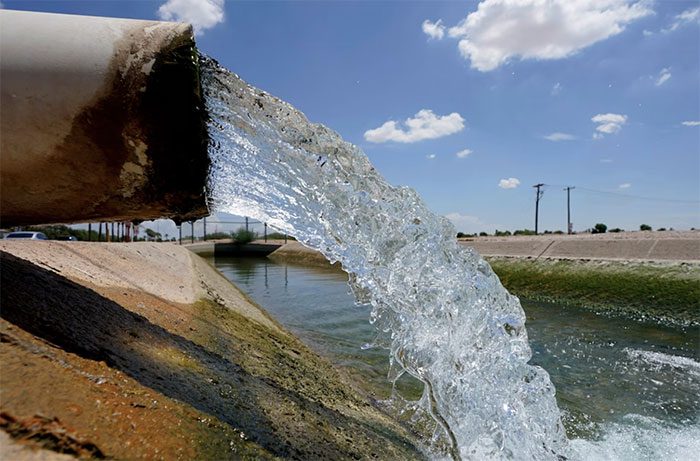Water for agriculture, families, and communities comes from beneath our feet, but the extraction of this resource often goes unnoticed. Much like removing air from a balloon, the ground begins to sink.
Groundwater has historically been the lifeline in the Coachella Valley, California, USA. Water for agriculture, families, and communities flows from beneath us, yet the extraction process is often overlooked. Like taking air out of a balloon, the earth begins to sink.
From 1995 to 2010, many areas in the valley experienced subsidence of up to 0.6 meters, a phenomenon known as land subsidence. The ground became unstable, creating large cracks. Uneven subsidence has damaged the foundations of buildings and roads. The Coachella Canal began to sink to the extent that the flow of water was interrupted.
This scenario seems all too familiar, especially in densely populated, arid regions. Another city has over-extracted groundwater and started to experience subsidence, struggling with water demands and unstable land. However, unlike other sinking cities, water managers in the Coachella Valley have achieved a rare feat: they have halted the sinking process and even reversed some of it.

Water from the Colorado River is redirected through the Central Arizona Project. (Photo: AP).
Water managers have promoted new water conservation methods, utilizing the Colorado River and recycled water for non-potable uses (agriculture, golf courses) and even recharging groundwater. The rate of subsidence has decreased by 50 to 75% in many areas. The northern part of the valley has experienced a rise of up to 60 mm in the subsequent years.
“I have studied land subsidence for a long time, and we really don’t have many good stories to tell, but the Coachella Valley is one of them,” stated Michelle Sneed, a hydrologist at the U.S. Geological Survey.
Globally, excessive groundwater pumping is one of the main culprits behind cities experiencing subsidence. Some communities may only sink by a millimeter, making it difficult to notice significant changes, but those experiencing higher rates of subsidence will face increased flooding along coastlines and damage to infrastructure.
By 2024, researchers estimate that nearly one-fifth of the world’s population may live on land gradually sinking beneath their feet due to groundwater extraction.
So far, only a small fraction of affected areas are addressing how to slow or halt land subsidence.
Recharging Groundwater
Addressing land subsidence is not a simple solution unless groundwater extraction is stopped. However, ceasing to use groundwater is not feasible for communities that need to supply water to a large population.
Instead, an alternative approach is to recharge groundwater. This method is known as managed aquifer recharge, also referred to as “water banking.”
To understand how it works, we first need to learn how groundwater is stored and extracted. The ground consists of various layers of sediments. An aquifer, which may be near the surface or deep underground, is a layer of rock or sediment with many porous spaces between grains. These voids are well-connected, similar to a sponge. Aquifers can store water and allow water to flow easily through them. To extract water, imagine inserting a straw into the aquifer and sucking the water up.
A managed recharge system collects water to return to the aquifer. The water source can come from rainfall, flooding, treated wastewater, or river water. Water can be extracted to supply the community. The liquid added can also increase the volume back underground, but only to a certain extent due to the compacted clay layers in the soil.
Manoochehr Shirzaei, a remote sensing engineering expert, stated: “If you perform this managed aquifer recharge when there is water available, such as during seasonal flood events, that water can be treated and pumped underground for storage. You reverse the subsidence and save water for the following year or years to come.”
Several places around the world have implemented aquifer recharge systems and witnessed changes in subsidence, including the Coachella Valley, Santa Clara and Santa Ana in California, El Carracillo in Spain, the Negev Desert in Israel, Hilton Head Island in South Carolina, Perth in Australia, and Beijing.
However, most places install these systems primarily to better meet their groundwater needs. Addressing land subsidence is merely a bonus.
For example, in Orange County (California), over 2.5 million residents receive 85% of their water supply from groundwater through a recharge system. The county’s chief hydrogeologist, Roy Herndon, noted that they see minor fluctuations in land levels but do not observe worsening subsidence — a positive sign.
In Perth, Australia, researchers found that a managed aquifer recharge system has raised portions of the land by about 20 mm over 3.5 years.
Water managers are also testing managed aquifer recharge systems around Norfolk, which is experiencing some of the highest land subsidence on the East Coast of the USA.
Jamie Heisig-Mitchell, the water quality director for the Hampton Roads district, reported that while some land subsidence phenomena are due to natural processes, the majority of the changes are a result of groundwater extraction.
In a pilot project, Hampton Roads established a recharge system to treat wastewater and recharge 1 million gallons daily into the aquifer. Heisig-Mitchell mentioned that they initially set up this system to find a sustainable groundwater supply for the area because the Potomac River system is being overused. However, they have also observed the land is rising.



















































